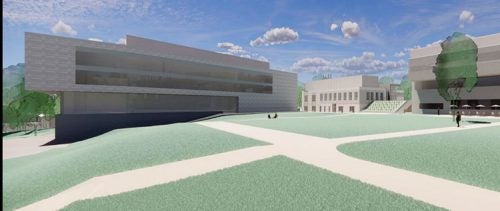The priorities and costs of projects on the drawing board remain under consideration. Conversations began early in 2021 after architects at Elllenzweig updated and revised the “2016 Master Plan.” The 2021 version of this document identified projects that make the strongest case for urgent need and immediate impact. Ultimately, the number and scope of these projects will match available resources.
Campus-renewal projects still in development will reshape the campus — adding new buildings and replacing outdated facilities while campus flow and green spaces are redesigned to be more pedestrian friendly.
Throughout these discussions, leaders and planners remain mindful that their solutions must be affordable. Private donations will be critical. Not only will philanthropy demonstrate tangible support from the private sector, it can add to the momentum already generated by R.I.’s citizens, who approved state-level borrowing.
“We’re an economic engine for Rhode Island. We bring in three dollars in federal money for every state dollar we receive. To keep doing that, we have to make sure our facilities and space meet our needs,” said GSO Dean Paula Bontempi.
Projects in Development
Ocean Frontiers Building
 In many ways, the single greatest project of campus renewal will be to demolish Horn Laboratories and construct a new facility in its place. While the Ocean Frontiers Building has surpassed a critical funding threshold, its exact footprint, size and configuration remains a work-in-progress as architects match its cost to available funds.
In many ways, the single greatest project of campus renewal will be to demolish Horn Laboratories and construct a new facility in its place. While the Ocean Frontiers Building has surpassed a critical funding threshold, its exact footprint, size and configuration remains a work-in-progress as architects match its cost to available funds.
When complete, a larger building will feature adaptable laboratory space that can be expanded and contracted to accommodate changing research needs; advanced power systems and HVAC systems as required by many research instruments and computer networks; and enough space to accommodate GSO’s growth aspirations. Faculty members who will work in the Ocean Frontiers Building continue to collaborate on the new building’s design so that laboratories and classrooms meet the needs of their research and instruction. “They will literally design their laboratories around the things that they want to accomplish,” said GSO Dean Paula Bontempi. “The sky is the limit, and I’m really excited to hear their ideas.”
According to Bontempi, Ocean Frontiers will also be designed with new faculty members in mind. In addition to those presently occupying Horn Lab, a new structure would also have space for scientists who have complementary interests to make collaboration easier. “And instead of wondering where we can squeeze new faculty in, the new facility will allow us to intelligently allocate research space in the most appropriate ways,” Bontempi said.
The new building’s site is just south of Horn in order to maintain the current quad, and to facilitate phasing by allowing construction to be completed before demolition of Horn and relocation of its occupants.
Ocean Engineering Building
Ocean Engineering, a department of URI’s College of Engineering, conducts undergraduate classes and labs as well as faculty research. OE facilities are currently located on the far south side of campus, housed in two structures that are outmoded and generally substandard.
Plans for campus renewal aim to replace these two sheet-metal buildings. The new ocean engineering facility will house dedicated office, laboratory, and classroom space for the Department of Ocean Engineering, along with a 100-meter-long wave/tow tank, 30x30x30 foot acoustics tank, and additional flumes for conducting coastal research. The building would provide research lab space for each faculty member, an accommodation currently lacking. The expansion for teaching and research is driven by the desire of faculty to conduct experiments and testing not possible currently. Also included would be a mechanical/carpentry shop, an electronics shop and a high-bay assembly area.
